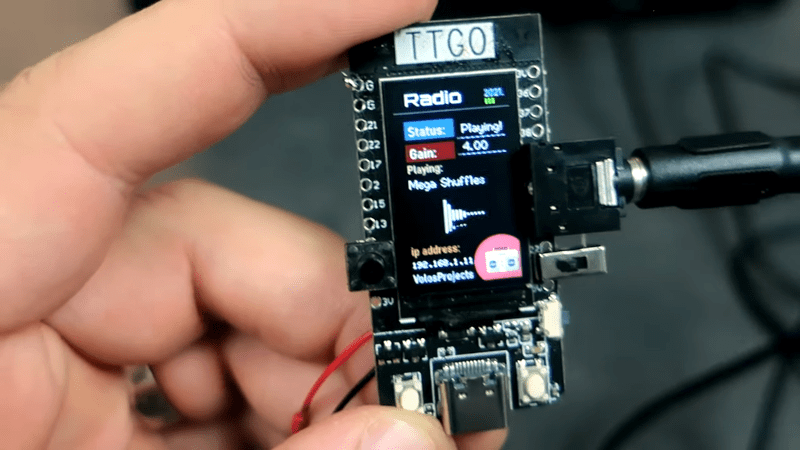More than once, we’ve looked at a cool board like the TTGO T-Display and thought, “What can we build with this?” If you’re [Danko Bertović], the answer is the tiny Internet radio you can see in the Volos Projects video below.
Of course, the core Internet streaming code would be useful with any ESP32, but the display makes for a good-looking unit. The code is available on GitHub. With judicious use of network and audio libraries, the player only takes a few hundred lines of code. Pretty impressive considering it even shows a visualization on the tiny display screen.
What we’d really like to see is a nice case, power supply, and speaker option to make a tiny and portable unit. With a 3D printer, it is easy to make very professional-looking projects, as we often see. On the other hand, it does look better than the breadboard version you can see towards the end of the video. It is, though, a neatly done breadboard.
If you want a larger screen, you might enjoy the ESP32 internet radio we looked at before. Probably our favorite case for an Internet radio was this globe.















There is a mistake in the “Posted in”, if this is ESP32, this isn’t ARM, this is Espressif LX6 or RISC-V ISA. Here is an LX6.
Popolon said: ‘There is a mistake in the “Posted in”, if this is ESP32, this isn’t ARM, this is Espressif LX6 or RISC-V ISA. Here is an LX6.’
The cores in the TTGO T-Display’s ESP32 are not “Espressif LX6”, they are known as “Tensilica Xtensa LX6” [1] microprocessor cores or IP (Intellectual Property) that is licensed to Espressif for use by the owner Cadence Design Systems [2] who bought Tensilica [3] in April 2013. Both Tensilica and Cadence Design Systems were/are based in San Jose, California.
1. January 12, 2015 PR: Latest Tensilica Processors Deliver Up to 75% Memory Power and Area Savings
https://ip.cadence.com/news/514/330/Latest-Tensilica-Processors-Deliver-Up-to-75-Memory-Power-and-Area-Savings
2. Cadence Design Systems – Intellectual_Property
https://en.wikipedia.org/wiki/Cadence_Design_Systems#Intellectual_Property
3. Tensilica – Xtensa Configurable Cores
https://en.wikipedia.org/wiki/Tensilica#Xtensa_configurable_cores
Looks very nice but there’s no schematic I can find. One can possibly figure it out, but why follow the chinese way and not provide complete (minimal) documentation?
Anyways, very cool design, I’m just trying to make it.
Same here.. I googled a bit and it seems to use internal DAC of ESP32.. Maybe even mono? 8-bit? https://www.esp32.com/viewtopic.php?f=19&t=21587
https://github.com/earlephilhower/ESP8266Audio/issues/95
There is no schematic because it employs a ready made board, the TTGO T-Display, and uses its internal DAC, although in the code there are options to use an external one via i2s.
http://www.lilygo.cn/prod_view.aspx?TypeId=50033&Id=1126
That board can be easily bought on Ebay (cheaper) or Amazon.
Of course it can be adapted to other ESP32 modules and displays by modifying the LCD part of the source.
Yes, so that’s not ARM, but LX6 architecture